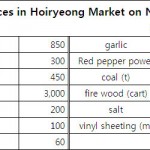According to the Daily NK:
According to a former North Korean logger in Russia, instances of forestry workers running away from a “Forestry Mission” program organized by North Korea’s Forestry Ministry in the Russian Far East are increasing due to excessive salary deductions currently being imposed by the North Korean authorities.
Song Ki Bok, a 48-year old former logger who now lives in South Korea told The Daily NK on November 18th, “The Forestry Mission takes 70% of monthly salary in the name of Party funding. Who would want to work there when all the money you earn from working yourself to death is taken from you?”
Prior to 2008, North Korea took 30% of the North Koreans’ wages for “Party loyalty funds”. However, after sanctions put in place by the international community following the first North Korean nuclear test began to bite, the amount was increased to 70%.
The North Korean forestry workers do hard physical labor. Depending on the intensity of their work, they receive just $40 to $100 per month.
Therefore, once 70% is deducted as Party funds, the take-home pay of the worker is between $12 and $30. As a result, workers cannot even dream of wiring sums back to family in the North. They just deliver what cash they can gather via colleagues returning home.
Worse yet, with this kind of swingeing monthly deduction, many workers cannot even recover the bribe they had to offer Party officials in order to be sent to Russia in the first place. For example, the total amount Song ended up paying was nearly $400.
Before escaping from the forestry program, Song saw a monthly salary of $30, meaning that even if he had saved every penny he earned for a year he still would not have recouped the $400 he paid out in bribes.
In the beginning, he was buoyed by the ‘Russia Dream’. The family of a worker in a foreign country traditionally lives in better conditions than most people. Therefore, Song went to Russia in the belief that if he worked hard for three years, he could make 10 years of a North Korean working man’s salary; however, the reality was as harsh as the bitter cold of Siberia.
The Forestry Mission in Russia; Kim Jong Il’s hard currency provider
According to Song, there are 17 forestry sites in Russia which employ North Koreans. Depending on the size of the camp there are differences; however, approximately 1,500~2,000 North Koreans work at each.
The major activities of the Party Committee in each camp are surveillance and the collection of Party funds. A manager, Party secretary and an agent from each of the National Security Agency and People’s Security Ministry are assigned to each site, and 15 administrative officers below them manage operations.
The life of workers is the same as it would be if they lived in North Korea. They must partake of weekly evaluation meetings, and food is provided by distribution. They plant potatoes and wheat in cleared areas near their digs to supplement the insufficient state provisions.
If workers leave without permission, they are punished upon their return. If the crime is grave, the worker might be summoned to North Korea for reeducation.
Song commented, “Sometime people leave the camp to go hunting to earn money. They can only escape punishment by bribing the management.”
In total, the amount gathered in the name of Party funds by the North Korean authorities from each camp can exceed $140,000 per month. Calculations suggest that the annual North Korean government take from the program exceeds $25 million.
However, this harsh Party policy is driving escapes, according to Song, “Since most of their monthly salary began to be taken away as Party funds, the number of workers escaping started to increase. Just from those I know, the average has reached 30 workers per a year.”
Song, describing the harsh working conditions at the site, said, “In 2006, a wood cutter from Dukcheon in South Pyongan Province who had frostbite in both feet at work didn’t receive treatment in time. In the end, they had to cut off both his legs. His co-workers, who could not ignore the situation, raised it with the Party Committee there; however, not only was this opinion ignored, but the wood cutter was sent home with the explanation, ‘It was an accident caused by my own carelessness’.”
“The life of a forestry worker fighting against cold which can reach -40˚C in winter is unspeakably tough,” Song said. “Meanwhile, they don’t even receive a proper month’s salary, which reduces their will to work.”
“If a worker escapes, in the end he has no choice but to head to South Korea. When I think about those of my colleagues who couldn’t come to South Korea with me, it is still hard to sleep at night.”
Read more about logging camps in Russia (including satellite imagery) here and here.
Read the full story here:
Runaway Loggers on the Rise Due to Wage Cuts
Daily NK
Kang Mi Jin
11/22/2010

